| Article ID | Journal | Published Year | Pages | File Type |
|---|---|---|---|---|
| 6203047 | Vision Research | 2016 | 13 Pages |
â¢We present a new clinical test which quantifies face discrimination sensitivity.â¢The test is highly repeatable and fast to administer (approximately 4 min).â¢A significant inversion effect was identified with the new test.â¢There are no floor or ceiling effects: normal variations can be detected.â¢The test is more sensitive to impairments of face perception than existing tests.
This study aimed to develop a clinical test of face perception which is applicable to a wide range of patients and can capture normal variability. The Caledonian face test utilises synthetic faces which combine simplicity with sufficient realism to permit individual identification. Face discrimination thresholds (i.e. minimum difference between faces required for accurate discrimination) were determined in an “odd-one-out” task. The difference between faces was controlled by an adaptive QUEST procedure. A broad range of face discrimination sensitivity was determined from a group (NÂ =Â 52) of young adults (mean 5.75%; SD 1.18; range 3.33-8.84%). The test is fast (3-4Â min), repeatable (test-re-test r2Â =Â 0.795) and demonstrates a significant inversion effect. The potential to identify impairments of face discrimination was evaluated by testing LM who reported a lifelong difficulty with face perception. While LM's impairment for two established face tests was close to the criterion for significance (Z-scores of â2.20 and â2.27) for the Caledonian face test, her Z-score was â7.26, implying a more than threefold higher sensitivity. The new face test provides a quantifiable and repeatable assessment of face discrimination ability. The enhanced sensitivity suggests that the Caledonian face test may be capable of detecting more subtle impairments of face perception than available tests.
